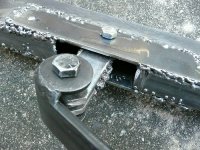I was on garage journal and I love what someone said about welding the ball on flush being a poor design even if it was done by a pro. I still wouldn't want to rely on just the weld holding that ball on with all the force a trailer will put on the ball.
There needs to be something else taking the force and not just the welds around the ball and it sitting flush. If I ever had a need again to weld a ball to a hitch without the shank I'd drill the hole out for the size of the ball and slide the ball through the hole and then weld both the top and bottom. But I'm not gonna attempt that until I get better at welding.
For now I'll just practice welding hitch balls on things such as garden tractors that won't see the highway. A ball breaking off on a garden tractor pulling a little trailer around the yard will hopefully only be an inconvenience and not a deadly incident.
Once again. I'll still use this hitch I made for now. But only to move the trailer around our yard and on our private road. This hitch will never see the public roads again as after reading the post below I have to agree that having the ball on flush is a poor design even if the welds are done correctly.
If I were to weld 2 square tubes together I'd add gusseting. I even added gusseting to the channel iron that I made the loader mounts with for my garden tractor. I didn't want to just rely on those welds holding channel iron together. So why in the he double hockey sticks I thought it was a good idea to just rely on the welds for this ball I don't know.
But now I know it's not a good idea and especially after seeing that broken hitch.
I don't recommend anyone welding up the ball like I did. As it is indeed a poor design. Even if you can do code quality welds. The ball needs to either have the shank still on it to take the force or at least cut the hole for the weldable ball and sit the ball down into the hole and then weld it so the ball will help with the force.
Don't do like I did and rely just on the weld to take the force. I did a big no no.
Show us your welding projects - Page 111 - The Garage Journal Board
In my opinion, this is a truly poor design for towing even if the welds are done correctly. Here's why...
Having the ball simply sitting flush on the surface of the ball mount and being connected only by the weld around the perimeter of the ball may not provide sufficient strength to withstand the shear stress and torque placed on it when pulling the trailer. Additionally, it is incapable of absorbing the tremendous shock loading caused by the trailer slamming back and forth into it. This causes the weld itself to be the "weak link" in the whole chain. This is one reason why most ball mounts are made of rather thick plate steel that is drilled through to accept a ball that has a shaft that extends through the plate. This design relies on the shaft strength rather than the welds.
The shaft and ball are probably constructed from one solid forging and are designed so that the shaft itself is large enough to withstand the forces involved. This design usually has a threaded shaft and nut to hold the ball in place but some types are welded around the perimeter of the ball as well as at the bottom of the shaft. In either case the forces are transmitted through the ball and shaft to the ball mount and do not rely on the weld strength to any significant degree.
Chad

